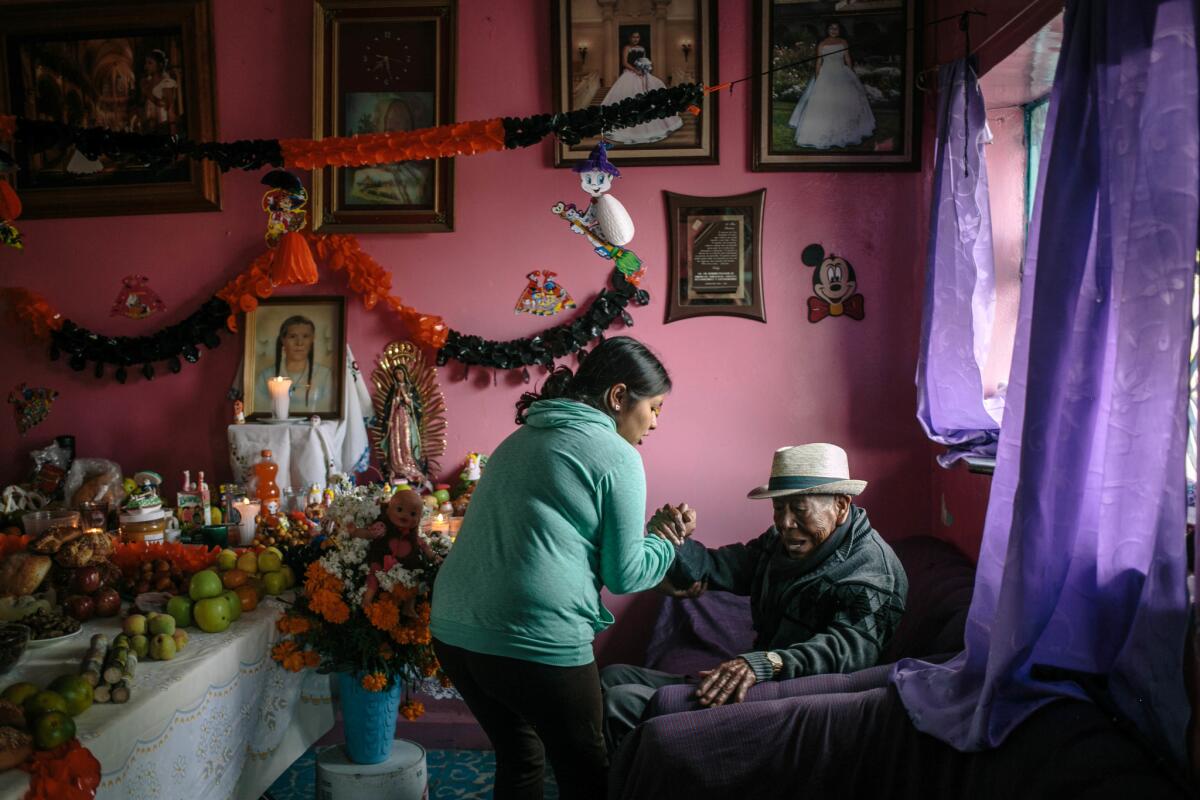Why everyone needs a Day of the Dead

- Share via
Everything I know about Día de los Muertos I learned while living in Mexico.
In Oaxaca and Michoacán, two states with deeply rooted Muertos traditions, I saw how lifelong practitioners dressed their ofrenda altars with precise additions according to the fancies of the departed person being honored: a plate of mole, just so; a specific reposado tequila, served neat; a certain brand of those tiny filterless cigarettes that are still sold down south. Everything had meaning, and a place in the spiritual order of the altar itself.
In the unending hustle of Mexico City, in the darkest days of the post-2008 global recession, neighbors in my downtown apartment building would gather around one another’s ofrendas and share warm chocolate and pan de muerto, or bread of the dead. Sometimes we’d carouse around the neighborhood cemeteries, drinking and partying, as Day of the Dead, in its traditional iteration, can also encourage mischief.
I began building my own ofrendas, first to family members and ancestors, then to friends and finally to people whom I greatly admired, like the California writer Michele Serros, or David Bowie. Day of the Dead always felt like a welcoming custom, one that anyone can participate in. After all, who doesn’t want a reason to focus fond thoughts on a lost loved one? Who doesn’t need a day to contemplate what awaits us all?
Since returning to the States, I’ve watched as Día de los Muertos has ballooned into a bonafide cultural phenomenon. Day of the Dead street fairs have become civic fixtures from coast to coast. Daycare centers and elementary schools hold arts and crafts, with children making paper skulls and mini-altars. Concerts, fundraisers, festivals and food events ring with Muertos cheer. Countless enthusiasts don calavera (skull) face makeup.
Its incursion into popular entertainment is also astounding. Look no further than the successful Pixar film “Coco,” a story built entirely around Day of the Dead motifs; or the opening sequence of the 007 film “Spectre,” in which a lavish Day of the Dead “parade” (itself a Hollywood fiction) became such a calling-card for its filming location in downtown Mexico City that the local government now re-creates the film’s scene-setting parade every year. Everywhere now, Muertos merchandise drowns the consumer market. We have Day of the Dead-inspired Halloween costumes, sneakers, shower curtains, sandals, donuts, and this year a Barbie doll, which promptly sold out.
At the root of it all, though, is a genuine ritual. In homes where the original practice is followed, preparations begin long before the actual celebration days of Nov. 1 and 2. With nightfall on Nov. 1 a bridge opens to allow a brief unification of the living and the dead. It’s visitation night for the residents of Mictlan, the underworld.
The holiday has roots dating back 3,000 years, said artist and scholar Martha Ramirez-Oropeza, who teaches a sought-after course on Día de los Muertos in the Chicano studies program at UCLA. “You can feel it as a deeper layer, that goes from pre-Hispanic times, to contemporary times, because when you see an ofrenda, you see parts of the history of Mexico.”
This week, Ramirez-Oropeza built ofrendas with students and participants at the longtime Venice arts center SPARC, and on the UCLA campus. Many of her students do not have Latino backgrounds, a sign that a custom centered on honoring one’s ancestors resonates with all of us.
If so inclined, you too can participate, by making a modest ofrenda at home. It’s quite easy, stripped to its basic rules. (Also, it’s helpful for the cynic seeking to offset the energy of a “Sexy Catrina” costume.)
First, an ofrenda should have at least two levels, and some of the offerings should come in sets of two — two vases for flowers, two candles, two sugar skulls, etc.
Photos and mementos to the dead should be on the top level. Below go food offerings — a piece of pan de muerto, a sampling of the dead person’s favorite food, a cigarette or favorite tequila or water (to quench the spirit’s thirst after the long journey from the land of the dead).
For flowers, if you’re unable to find those glistening cempasuchil marigolds, any flower will suffice in a pinch. Use petals to create a pathway to the altar. Burn Copal resin or a bit of sage as an invocation.
And that’s it. Stay up past midnight, reflect, send thoughts to those who’ve left us.
I’ve found, over the years since I adopted the practice, that building an ofrenda for a dead soul is a soothing experience. The ritual embodies the essential duality of Mesoamerican cosmology: There is no living without the dead, and no death without the living. In almost any interpretation, Día de los Muertos posits a universal truth: The dead need us as much as we need them.
Daniel Hernandez is a former staff writer at the Los Angeles Times, LA Weekly, Vice News and the New York Times. He’s author of the nonfiction book “Down & Delirious in Mexico City.”
More to Read
A cure for the common opinion
Get thought-provoking perspectives with our weekly newsletter.
You may occasionally receive promotional content from the Los Angeles Times.









